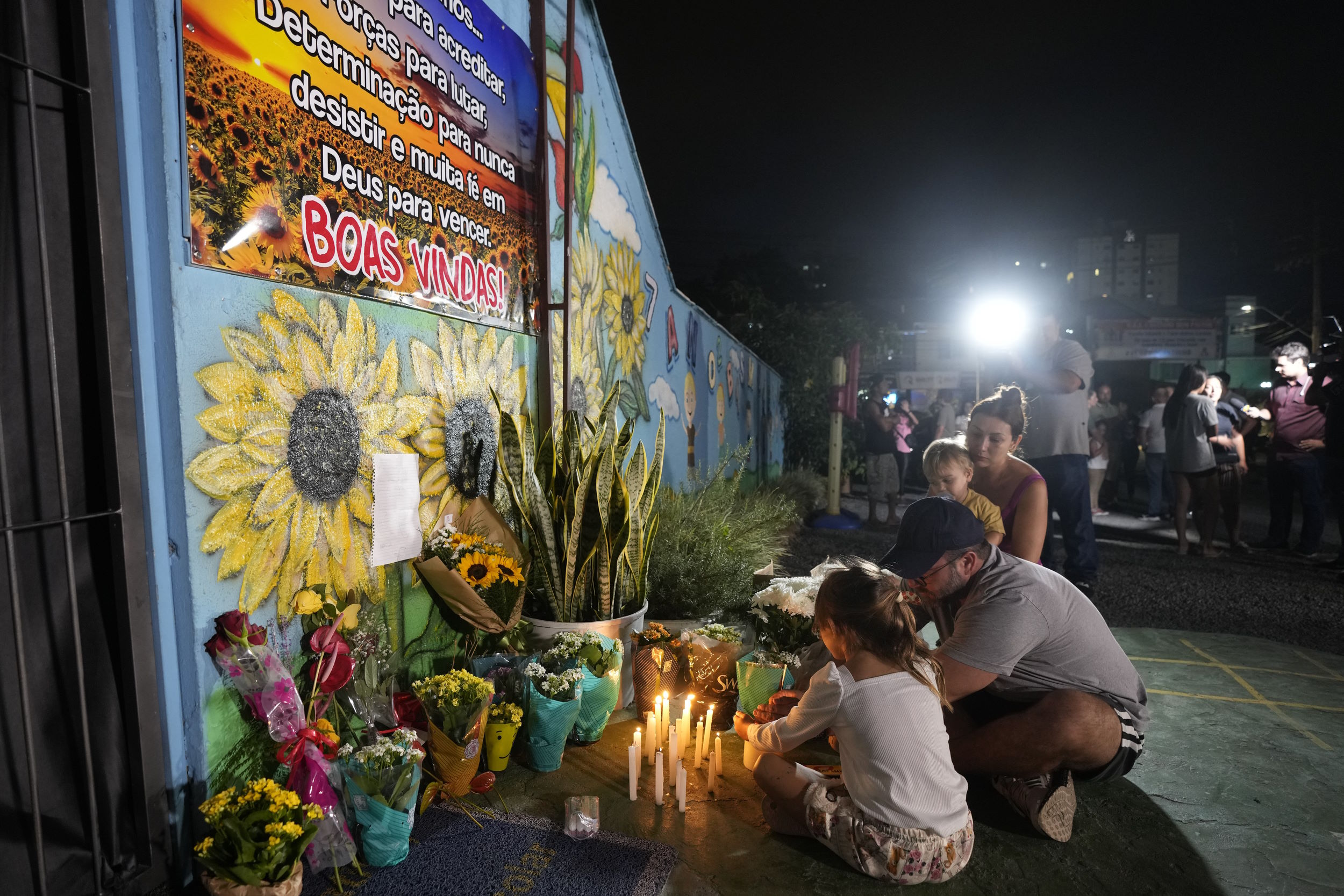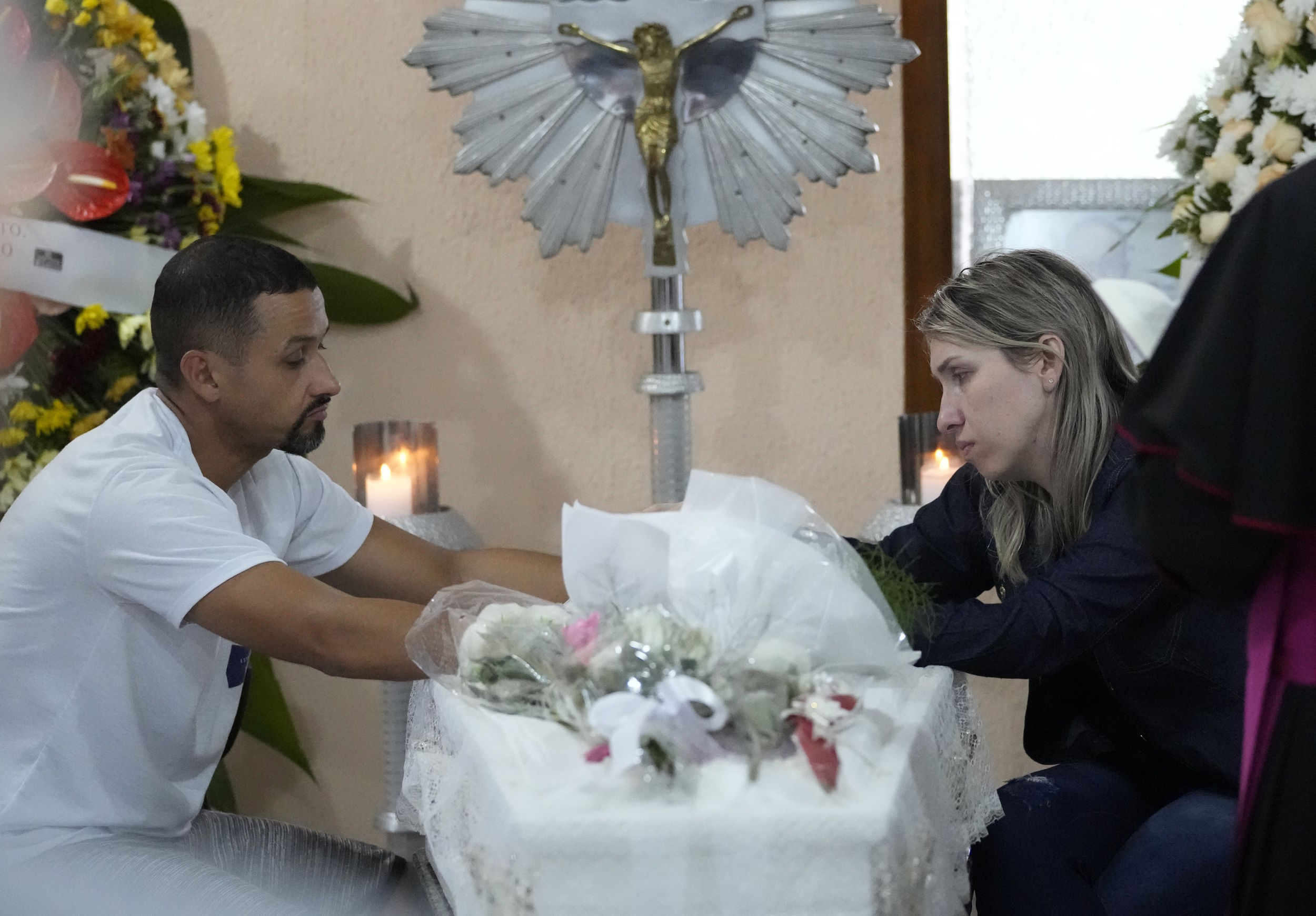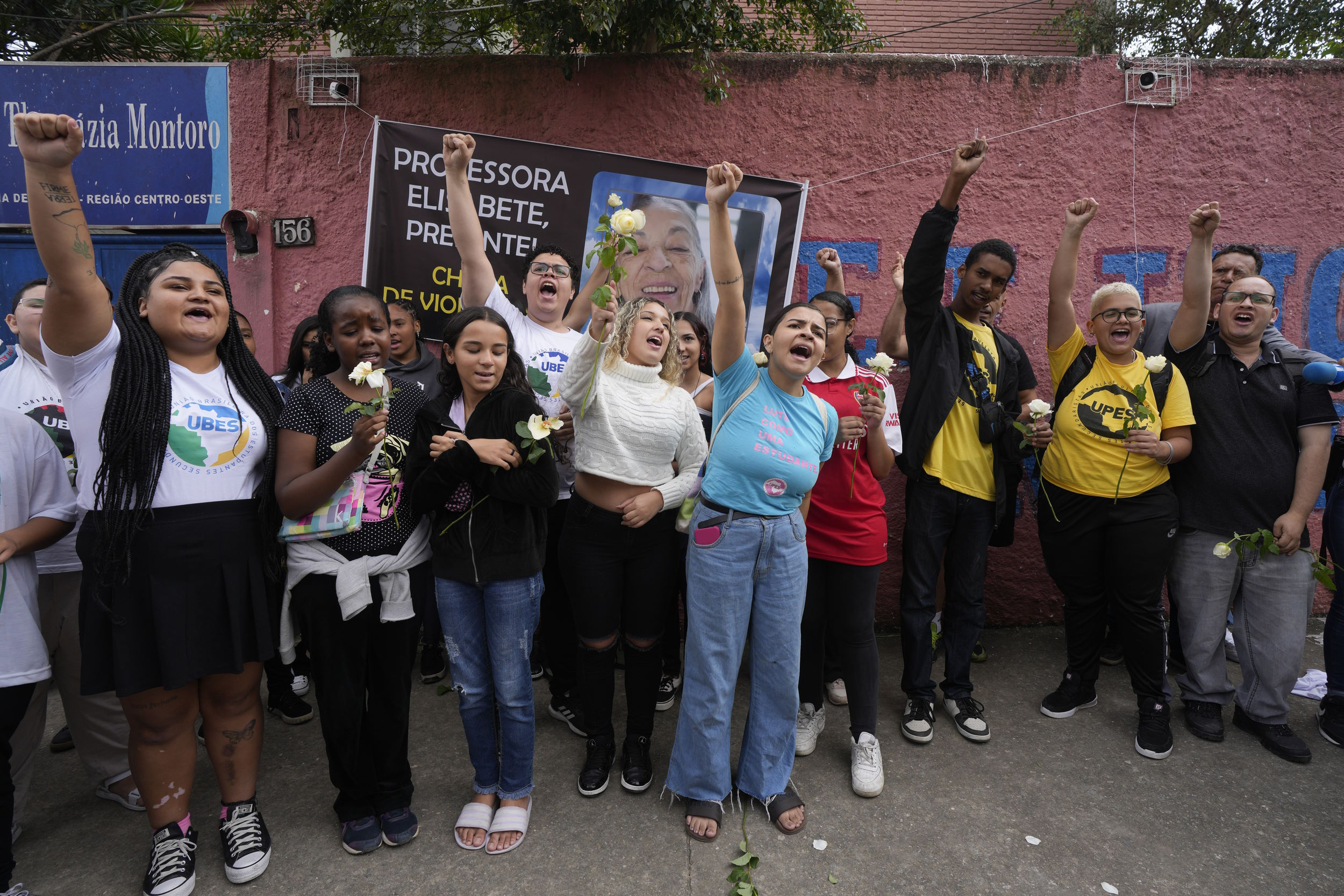About two weeks after a man killed four children in a Brazilian daycare center, authorities already have rounded up some 300 adults and minors nationwide accused of spreading hate speech or stoking school violence.
Little has been revealed about the unprecedented crackdown, which risks judicial overreach, but it underlines the determination of the country’s response across federal, state and municipal levels. Brazil’s all-hands effort to stamp out its emerging trend of school attacks stands in contrast to the U.S., where such attacks have been more frequent and more deadly for a longer period, yet where measures nowadays are incremental.
Actions adopted in the U.S. – and some of its perceived shortcomings – are informing the Brazilian response, said Renan Theodoro, a researcher with Center for the Study of Violence at the University of Sao Paulo.
“We have learned from the successes and the mistakes of other countries, especially the United States,” Theodoro told The Associated Press.
Brazil has seen almost two dozen attacks or violent episodes in schools since 2000, half of them in the last 12 months, including the daycare center attack April 5.
President Luiz Inácio Lula da Silva said the notion of schools as safe havens has been “ruined.” His government has sought input from independent researchers and this week convened a meeting of ministers, mayors and Supreme Court justices to discuss possible solutions.
Some measures already adopted are in line with those implemented over time in the U.S., like the creation of hotlines, safety training for school administrators and teachers, federal funding for mental health, plus security equipment and infrastructure.
Other measures — like the nationwide sweep for supposedly threatening suspects involving over 3,400 police officers, or the newly invigorated push to regulate social media platforms — have not been enacted there.
The arrests aim to assuage fear among Brazilians, said Luis Flávio Sapori, a senior associate researcher with the Brazilian Forum for Public Security. “The priority is diminishing panic,” he said.
In the weeks since the daycare massacre, unconfirmed threats and rumors have circulated on social media, and stirred dread among students, educators and parents — including Vanusia Silva Lima, 42, the mother of a 5-year-old son in central Sao Paulo.

Andre Penner/AP File
A family lights a candle at a makeshift memorial at the “Cantinho do Bom Pastor” daycare center after a fatal attack on children in Blumenau, Brazil, April 5, 2023.
“I am afraid of sending my son to school. Not only myself, my friends are too, women I met at the salon, too,” Lima said.
Many Brazilian states didn’t wait for the federal response. Sao Paulo, for example, temporarily hired 550 psychologists to attend to its public schools, and hired 1,000 private security guards.
While shootings in the U.S. often ignite debate, at the federal level it usually ends in stalemate. Democrats focus on gun control while Republicans push for stronger security measures.
Brazil’s push has garnered broad support in part because proposals haven’t included restricting firearm access, increasingly a hot-button political issue here, as in the U.S. Anyway, Brazil’s school attacks more often are carried out with other weapons, especially knives.
In the U.S., legislation rarely passes. There have been notable exceptions, however, including a bipartisan compromise approved last year after a massacre at a Texas elementary school and other mass shootings. The bill toughened background checks and kept firearms from more domestic violence offenders, and allocated $1 billion for student mental health and school security.
Other change has come more gradually since the 1999 Columbine High School massacre and the 2012 Sandy Hook Elementary School shooting. In almost every state, schools are now required to have safety plans that often include shooter drills. Many individual school districts have their own safety hotlines, and some use software to monitor social media for threats, with mixed results.
And many U.S. states have given schools money to “harden” buildings with metal detectors, security officers, bulletproof doors and other measures — which has stirred its own debate over the policing of America’s schools.
Lawmaker Eduardo Bolsonaro, the son of Lula’s far-right predecessor, was one of a few prominent voices calling for detectors and armed guards, citing some U.S. states as examples, and put forward a bill to make them obligatory at all schools.
Lula has said his government will consider neither detectors nor backpack inspections.
Sapori said that Brazil has adopted a mixed approach, which stresses mental health care, preventive monitoring of threats and training for teachers, in addition to policing.
“In Brazil, we have a clear understanding, based on the U.S. experience, that merely investing in armed security in schools does not work, that police presence in schools doesn’t hinder attacks,” Sapori said. “It only works to transform schools into prisons.”
For Brazil, the Western hemisphere’s second-most populous country, scrambling for quick solutions risks introducing abuses of power.
As for the suspects arrested over a two-week period through Thursday, Theodoro noted that authorities haven’t detailed the criteria for detentions, and investigations are under seal. Asked by the AP, the Justice Ministry declined to clarify how many of the 302 people taken into custody were minors.

Andre Penner/AP File
Parents sit alongside the coffin that contain the remains of their seven-year-old Larissa Maia Toldo, who was killed by a man with a hatchet inside a day care center, during a wake at the Sao Jose cemetery, in Blumenau, Santa Catarina state, Brazil, April 6, 2023.
The ministry also has empowered a national consumer agency to fine tech companies for not removing content perceived as glorifying school massacres, incentivizing violence or making threats.
And there appears to be broad support for holding social media platforms accountable. At this week’s meeting in the capital, Lula, his justice minister, two Supreme Court justices, and the Senate’s president voiced support for regulation of the platforms, arguing that speech that is illegal in real life cannot be permitted online.
“Either we have the courage to discuss the difference between freedom of expression and stupidity, or we won’t get very far,” Lula said.
The Rights in Network Coalition, an umbrella group of 50 organizations focused on basic digital rights, has expressed concern over giving the government the power to decide what can be said on social media.
Some social media platforms that initially resisted compliance with takedown requests have come around and, in the prior 10 days, had removed or suspended more than 750 profiles, Justice Minister Flávio Dino said.
When a man hopped over the wall of a daycare center in Santa Catarina state and killed four children with a hatchet April 5, state prosecutors called on news media to refrain from sharing images or identifying the killer, citing research that this can encourage other attackers.
Behemoth media conglomerate Grupo Globo announced it would no longer name nor portray perpetrators of such crimes in its broadcasts or publications. O Estado de S. Paulo, one of Brazil’s biggest newspapers, followed suit. CNN Brasil and Band also made the change.
In the United States, such a broad shift is yet to be seen in media, though outlets have begun efforts to use shooters’ names sparingly and to focus on victims’ stories, largely due to advocacy by relatives of victims. Some U.S. news organizations have ceased the previously routine profiles of school shooters.
The developments in Brazil are reminiscent of a groundswell of U.S. federal support for school safety after the Columbine shooting, said Ken Trump, president of Ohio-based consultant National School Safety and Security Services.
“Since then, it has become much more choppy,” he said.
The success of Brazil’s efforts will hinge on the ability to maintain momentum even after public attention shifts away from school violence, he added.
“The bottom-line question is, will it be sustainable?”
***
Binkley reported from Washington, D.C. AP journalists Eléonore Hughes, Maurcio Savarese and Carla Bridi contributed from Rio de Janeiro, Sao Paulo and Brasilia.



























